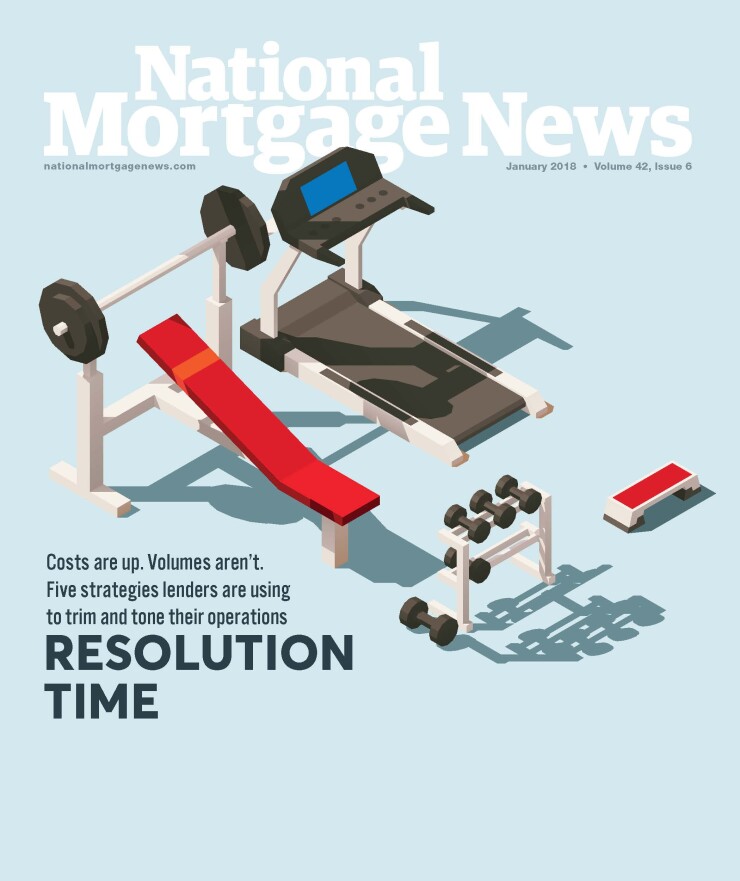
Editor's Note: This is part three of a five-part series on the strategies lenders are using to make their operations more efficient and profitable. Read
Mortgage lenders don't just use their strategic knowledge of government programs, real estate and finance to sell mortgages, they also use it to get the most out of their facilities and equipment costs.
Movement Mortgage, for example, got a $660,000 grant from Virginia's Economic Development Partnership to support its effort to lease and renovate space in a former J.C. Penney storefront
Embrace also has experimented with the use of remote underwriters using what President Kurt Noyce calls "the virtual office concept," which can reduce the need for facilities and associated costs.
"I know plenty of lenders who will hire remote underwriters all day long," said Stratmor Group Senior Partner Garth Graham. "Not every lender is comfortable with that, but it does change how much is spent on fixtures, furniture and equipment."

With a growing amount of common off-the-shelf lender technologies like loan origination systems and customer relationship management platforms delivered via software-as-a-service, many lenders are already operating in smaller spaces as well as allowing some remote work to be done.
The typical lender spends hundreds of dollars per loan on technology, facilities and equipment, compared to the thousands per loan spent on compensation. Tech budgets might only be more sizable among very large lenders, particularly if they develop and maintain proprietary systems.
"We're not spending a lot on technology, even with all the digital solutions coming," said Graham. Roughly 30% of lenders have some form of digital point of sale technology in production and another 30% have some form of it in production, but the remaining 40% of the industry doesn't, he added.
Part of the problem is that technology savings can be so meager, given the upfront investment.

Embrace's spending on the energy-efficient solar panels won't produce true savings for several years, and Movement Mortgage COO John Third cautions not to overestimate the immediate efficiencies from a new digital point of sale system, noting that the reorganization of its support staff had a more immediate impact.
Movement Mortgage utilizes a self-service point of sale system from digital mortgage technology developer Blend Labs alongside its LOS from PCLender, a vendor that
The Blend technology offered savings because it helped Movement collect more data, avoid paper and verify information faster. So far, the technology has helped cut about half a day from loan processing times.
"But we've only been using it for a year," Third said. "I think you still have customers out there who are wary about how they provide their data. We're expecting to see additional gains as the consumer becomes more comfortable with how they provide data for a mortgage application."
"The overall critical control feature is for management and the finance department to just be able keep a constant eye on the budget."
— Bill Napier, chief financial officer, Homespire Mortgage
There may be additional savings from the government-sponsored enterprises' representation and warranty relief efforts for loan information that can be validated with automated services available from Fannie Mae, Freddie Mac and their approved vendors. But Movement isn't far enough along in implementation to see any efficiency gains yet, Third said.
While digital platforms are a long-term need, the first priority for lenders is to ensure they have automation that examines their own finances on a continuous, real-time basis and couple it with peer group metrics offered by trade groups and industry cooperatives.
Accounting automation is providing more detailed, real-time analysis of compensation, which represents a huge chunk of loan costs, but is becoming more complex as lenders compete through the use of different override and commission structures, said Advantage Systems President Brian Lynch.
"You are able to do importation of what would be very voluminous journal entries, so that helps to keep costs down," said Bill Napier, chief financial officer at Homespire Mortgage. "The overall critical control feature is for management and the finance department to just be able keep a constant eye on the budget, knowing they should have the ability to forecast and have readily available plans to implement in the event of whatever scenario is playing out."





